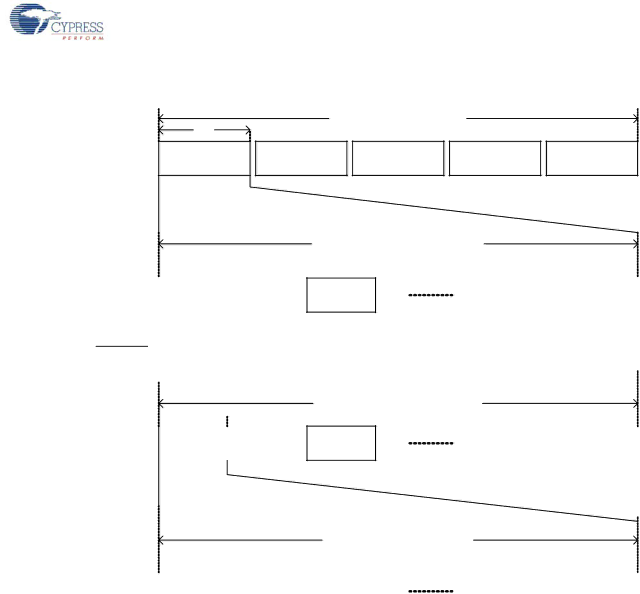
WirelessUSB™ Protocol 2.2
Figure 2-6. Bind Timing Diagram
4.16s x 5 Cycles ~ 21 seconds
4.16 s
Cycle 1
Cycle 2
Cycle 3
Cycle 4
Cycle 5
Bridge
320 ms x 13 Channels ~ 4.16 seconds
![]() 320 ms
320 ms![]()
![]() 320 ms
320 ms![]()
![]() 320 ms
320 ms![]()
Channel 0 |
| Channel 6 |
|
|
|
![]() 23.4 ms
23.4 ms![]()
Cycle 1 |
| Cycle 2 |
|
|
|
Device
Channel 12
23.4 ms x 1000 Cyles = 23.4 seconds
Cycle 3
1.80 ms x 13 Channels = 23.4 ms
Channel 72 |
| Channel 78 |
|
|
|
Cycle 999 |
| Cycle 1000 |
|
|
|
![]() 1.8 ms
1.8 ms![]()
![]() 1.8 ms
1.8 ms![]()
![]() 1.8 ms
1.8 ms![]()
Channel 0 |
| Channel 6 |
| Channel 12 |
|
|
|
|
|
Channel 72 |
| Channel 78 |
|
|
|
The bridge uses the RSSI to determine the noise level on the channel. If the channel has become noisy, the bridge moves to ping mode to find a quieter channel in its channel subset.
When the HID loses connection with the bridge, it moves to reconnect mode to find the bridge. The HID sends a connect request packet and listens for an AutoACK packet. If the HID receives the AutoACK, it immediately enables its receiver and listens for the connect response packet from the bridge. If the HID does not receive the AutoACK it selects the next channel using the channel selec- tion algorithm and repeats this procedure. As shown in the reconnect timing diagram below, the reconnect attempt takes approximately 1.76 ms/channel. The HID moves through its channel subset up to 19 times before it times out and exits reconnect mode. The keyboard tries to send the data for up to five seconds, and the mouse tries for two seconds, causing the HID to
CY4672 Reference Design Guide, Document # | 27 |
[+] Feedback
